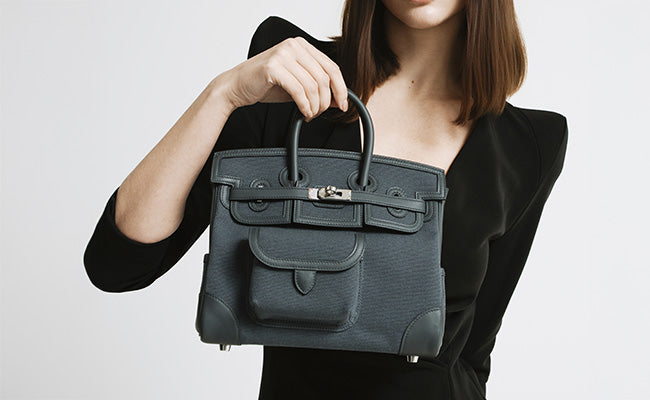
Color Transfer 101: Preventing Denim/Dye on Light Leathers
Check out our Hermès collection and Birkin bags!
Light leather handbags and accessories are investment pieces that deserve protection from one of the most common threats they face: dye transfer from denim and dark clothing.
Whether you're carrying a pristine white Birkin or sporting cream-coloured leather seats, that dreaded blue tinge from your favourite jeans can appear seemingly overnight, turning your luxury item into a source of frustration.
Denim dye transfer happens when unfixed dyes from clothing dissolve due to moisture, heat, or friction, then bond with the porous surface of light leather.
This chemical reaction occurs most readily with untreated or lightly finished leathers, which is why your most beautiful pieces are often the most vulnerable.
We've all been there. Discovering that telltale blue shadow on our beloved leather goods after a day of wear.
The key to keeping your light leather collection pristine lies in prevention rather than cure, and the strategies are surprisingly straightforward once you understand the science behind dye migration.
Key Takeaways
- Dye transfer occurs when unfixed dyes from clothing dissolve and bond with porous leather fibres through moisture and friction
- Prevention techniques include proper fabric care, protective barriers, and choosing appropriate leather treatments and storage methods
- Quick action with proper cleaning techniques can often reverse dye transfer damage before it becomes permanent
Why Denim and Dye Transfer Happens on Light Leathers
Understanding dye transfer means looking at how unfixed dye molecules from fabrics like denim migrate to leather surfaces through moisture and friction. Light-coloured leathers are especially at risk because their porous structure and lack of pigment offer little defense.
Understanding Dye Transfer vs. Colour Bleeding
Dye transfer and colour bleeding aren't quite the same thing. Dye transfer happens when unfixed dye particles from clothes physically move to leather surfaces through direct contact, friction, and moisture.
Colour bleeding, on the other hand, is when dyes dissolve in water and spread within the same material. That mostly messes up the original fabric, not whatever it touches.
During denim manufacturing, cotton fibres get saturated with indigo and other dyes to achieve those deep blue, black, or grey shades. But not all dye molecules stick to the cotton for good.
Water-soluble dyes and fat-soluble dyes used in denim can reactivate when exposed to sweat, humidity, or rain. Fresh jeans pose the highest risk because excess surface dye hasn't been removed through washing.
The transfer happens when these loose dye molecules encounter leather through prolonged contact, creating permanent stains that penetrate the leather's surface.
How Leather and Fabrics Interact
Leather and fabric interactions create perfect conditions for dye migration through several mechanisms. Friction between denim and leather generates heat and physical pressure that loosens dye particles from fabric surfaces.
Moisture acts as a catalyst in this process. Human sweat contains salts and minerals that help dissolve dye molecules, making them mobile and ready to transfer.
Body heat increases the activity of these dye molecules. When we carry leather bags against clothing or sit on leather seats wearing jeans, we create warm, slightly moist environments.
The porous structure of leather allows these activated dye molecules to penetrate beyond the surface. Unlike synthetic materials with protective coatings, leather readily absorbs foreign substances.
Cotton denim is particularly problematic because its loose weave structure releases dye particles more easily than tightly woven fabrics. Dark-coloured denim contains higher concentrations of unfixed dyes compared to lighter fabrics.
Light Leather: Why Is It So Vulnerable?
Light leather's vulnerability comes down to its minimal pigment content and how easily colour changes show up. White, cream, and nude leathers just don't have the dense pigmentation that hides transferred dyes in darker leathers.
Aniline-finished leathers are especially susceptible because dyes penetrate directly into the leather without surface protection layers. These premium finishes showcase leather's natural texture but offer no barrier against foreign dyes.
The contrast factor makes things worse. Dark indigo dye against light leather creates stark, noticeable stains that are immediately visible and tough to ignore.
Untreated leather surfaces absorb dye molecules quickly and deeply. Many luxury leather goods use minimal surface treatments to maintain their natural feel and appearance.
Light leathers also show wear patterns more readily, creating tiny rough spots where dye particles can settle more easily. This textural change increases the leather's ability to trap transferred colour.
The Science of Dye, Denim, and Textile Bleed
If you want to protect your light leathers, it helps to know a bit about how dyes bond with fabric fibres and why some materials transfer colour more than others. The friction between denim and leather plays a crucial role in this transfer process.
How Dyes Are Fixed in Fabrics
Dye fixation determines whether our favourite jeans will bleed onto our Birkin bags. During manufacturing, dye molecules form chemical bonds with fabric fibres through various processes.
Direct dyes create weak bonds and are notorious for bleeding. Reactive dyes form stronger covalent bonds with natural fibres, making them more stable.
The dyeing process leaves excess dye on fabric surfaces, especially in denim. This surface dye hasn't bonded properly and becomes the culprit behind colour transfer.
Heat treatment and chemical fixatives help lock dyes into fibres. However, some manufacturers skip these steps to reduce costs, leaving us with bleeding garments.
Cotton vs. Polyester Jeans: The Colour Bleed Factor
Cotton and polyester behave differently when it comes to dye bleeding, affecting how they interact with our leather accessories.
Cotton fibres are porous and absorb more dye during manufacturing. This porosity means cotton holds more surface dye that can transfer. The natural fibre structure makes cotton more prone to fade and bleed.
Polyester fibres are synthetic and less porous. They require different dye types and typically hold colour more securely. Polyester jeans generally pose less risk to our leather goods.
Raw denim, usually 100% cotton, presents the highest risk. The indigo dye sits heavily on the surface, ready to transfer onto anything it touches.
Blended fabrics combine both characteristics, with bleeding tendencies depending on the cotton-to-polyester ratio.
The Role of Friction in Colour Transfer
Friction acts as the vehicle that moves dye from fabric to leather surfaces through physical contact and pressure.
Mechanical action breaks loose surface dye particles and transfers them through direct contact. The more we move, sit, or rub against surfaces, the more dye transfer occurs.
Heat increases friction's effectiveness by loosening dye molecules. Body heat, warm car seats, and sunny days amplify colour transfer risks.
Smooth leather surfaces like those on our luxury handbags provide perfect canvases for dye particles to adhere to. The leather's pores trap transferred dye, making removal challenging.
Minimize friction by avoiding prolonged contact between new denim and light leather. Breaking in jeans through multiple washes reduces surface dye availability for transfer.
Top Proven Ways to Prevent Colour Transfer on Light Leathers
Light leather pieces like cream Birkins or white Kelly bags need proactive protection from denim dye and fabric bleeding. We can safeguard these investments through smart daily habits, protective coatings, and strategic barriers.
Daily Habits: Seating, Storage, and Style Choices
The clothes we wear around our light leather bags make all the difference. Dark denim is the biggest culprit for colour transfer, especially when new or heavily dyed.
We recommend avoiding brand-new jeans when carrying cream or white leather bags. Fresh denim bleeds the most dye during the first few wears.
Strategic clothing choices:
- Wear lighter-coloured bottoms (beige, white, khaki)
- Choose pre-washed or vintage denim
- Layer with longer tops to create distance
Storage matters just as much. We store light leather pieces separately from dark fabrics in dust bags or boxes. Never stack leather items together without protective barriers.
Seating awareness prevents disasters. Avoid placing light bags on dark upholstery, car seats, or clothing. Restaurant booths with dark fabric pose particular risks.
Applying Leather Coatings, Sealants, or Protectors
Professional-grade leather protectors create invisible shields against dye transfer. We apply these treatments before first use for maximum effectiveness.
High-quality options include:
- Hermès leather care products (when available)
Apply protectors in thin, even coats using circular motions. Test on hidden areas first to ensure compatibility.
A leather fixative helps lock existing dyes in place, preventing them from bleeding onto other surfaces. This step is crucial for newly purchased bags.
We reapply protective treatments every 3-4 months or after cleaning. Weather exposure and regular use break down these barriers over time.
Pro tip: Use a leather cleaner before applying protectors to remove manufacturing residues that might interfere with adhesion.
Using Barriers and Covers
Physical barriers provide foolproof protection when chemical treatments aren't enough. We use several barrier methods depending on the situation.
Colour catcher sheets work brilliantly inside bags to absorb any dye that might transfer from contents. Tuck one sheet inside pockets and compartments.
For clothing, we wear base layers or jackets to minimize friction between fabrics and leather. Silk scarves or cotton shirts create effective buffers.
Car protection strategies:
- Place towels on dark car seats
- Use seat covers in leather vehicles
- Keep bags in protective dust bags during transport
Dust bags aren't just for storage. We use them as protective covers when placing bags on questionable surfaces like airplane seats or restaurant chairs.
Clear protective film designed for handbags offers invisible protection for high-wear areas like handles and corners where friction occurs most.
Laundry and Fabric Care for Dye Transfer Prevention
Proper laundry techniques are your first line of defence against denim dyes bleeding onto precious light leathers. Strategic washing methods, temperature control, and protective products can dramatically reduce colour migration risks.
Washing Instructions for Denim and Bright Fabrics
New denim pieces are notorious dye criminals. They'll bleed all over your favourite whites given half a chance. We always wash new jeans separately for the first three washes minimum.
Dark denim should be turned inside out before washing. This protects the outer surface while allowing trapped dyes to release safely into the water instead of onto other fabrics.
Bright fabrics like red cotton or deep navy pieces need similar treatment. We recommend these sorting guidelines:
- Darks: Black, navy, deep burgundy
- Mediums: Greys, muted colours
- Lights: Whites, creams, pastels
- Brights: Reds, electric blues, vibrant colours
Pre-treating heavily dyed items with a vinegar rinse helps set colours. Mix one cup white vinegar with cold water and soak for 30 minutes before the first wash.
Never overload your machine. Overcrowded loads create friction that encourages dye transfer between garments.
Best Practices: Cold Water & Gentle Cycles
Cold water is absolutely essential for preventing dye bleeding. Hot water opens fabric fibres and encourages colour molecules to migrate freely.
We use water temperatures of 30°C or below for all potentially problematic fabrics. This temperature effectively cleans while keeping dyes locked in their original fibres.
The gentle cycle reduces mechanical agitation that can force dyes out of fabrics. Standard cycles create too much friction and movement.
Shorter wash times also help. We prefer 15-20 minute cycles for delicate or heavily dyed items rather than extended washing periods.
Choose mild detergents specifically formulated for colour protection. Harsh chemicals can strip dyes and cause them to redistribute onto other fabrics in the load.
Air drying prevents heat-related colour bleeding that can occur in dryers. Heat from dryer cycles can reactivate dyes and cause transfer even after washing.
When to Use Colour Catcher Sheets
Colour catcher sheets are brilliant insurance policies when you're unsure about fabric stability. We use them religiously with new luxury pieces or when mixing colour families.
These sheets work by absorbing loose dye molecules from wash water before they can settle on other fabrics. They're particularly effective during the first few washes of new items.
Essential situations for colour catchers include:
- First wash of new dark jeans
- Mixed loads with questionable colour fastness
- Washing vintage or delicate luxury items
- When time constraints force mixing colours
One sheet handles regular loads, but we use two sheets for larger loads or when washing particularly problematic fabrics like new red cotton or indigo denim.
Dye fixatives offer another layer of protection. These products chemically bond with fabric dyes to prevent bleeding. Add them during the wash cycle according to package directions.
Replace colour catcher sheets after each use. They can't be reused once saturated with absorbed dyes.
Choosing and Caring for Light Leather Goods
The right material selection and proper maintenance routines form the foundation of keeping light leathers pristine. Quality matters more than price tags, strategic cleaning prevents damage, and environmental protection preserves that coveted lustre we all obsess over.
Material Quality Matters: Full-Grain, Aniline, and More
Not all leathers are created equal, especially when we're talking about those gorgeous light shades that make our hearts skip a beat. Full-grain leather offers the best resistance to colour transfer because it retains the hide's natural protective barrier.
Aniline leather, while buttery soft and luxurious, requires extra vigilance. Its open pores absorb dyes more readily than protected leathers. Semi-aniline options strike a balance between feel and protection.
Top-grain leather provides decent stain resistance with a more uniform appearance. However, it lacks full-grain's natural durability against colour bleeding.
When investing in light leather pieces, examine the finish closely. A slight protective coating can prevent years of heartache from denim stains. We've learned that spending a bit more upfront saves countless dollars in restoration costs later.
The leather's source matters too. Italian and French tanneries often produce superior colour-fast finishes compared to mass-market alternatives.
Selective Use of Leather Cleaners
Choosing a leather cleaner really does matter when it comes to those pale, gorgeous pieces. Not every product works for every type of leather, and the wrong formula can quickly make things worse. Think fading, dryness, or just weird spots.
pH-neutral cleaners are, honestly, your safest bet for everyday care. Anything too alkaline will just strip away the leather’s natural oils, leaving it thirsty and prone to stains. Always test any cleaner on a discreet corner first. You never know.
Aniline leathers need a gentler touch. Specialized foam cleaners get the job done without soaking the material. Full-grain leather can handle slightly more robust formulas, but don’t go overboard.
A quick weekly wipe-down stops dirt from building up and turning into permanent discolouration. Once a month, a deeper conditioning session keeps things soft and more stain-resistant.
Don’t even think about using household cleaners. Baby wipes seem gentle, but their chemicals sneak up and fade colour over time. Professional leather cleaners cost more, sure, but they actually protect your stuff.
Minimizing Sunlight and Heat Exposure
Direct sunlight is brutal on light leather. Fading can start in just a few months. We try to keep our best pieces away from windows, maybe throw up some UV-filtering film if we can.
Heat is just as sneaky. Radiators and fireplaces pull moisture out fast, making leather brittle and way more likely to crack or fade.
Rotation helps. We swap out handbags on display and move cushions around so everything ages evenly. Dust covers are a lifesaver when you stash things away for a while.
Car interiors? That’s a whole different headache. Even with dashboard cleaners that claim UV protection, parking in the shade makes the biggest difference. Those pale interiors need constant attention.
Humidity matters too. If it’s too dry, leather cracks. Too damp, and you’re fighting mold and stains.
What To Do When Dye Transfer or Stains Strike
If denim leaves its mark on your favourite leather bag, acting fast and smart can save the day. Here’s how to handle fresh stains, what cleaning methods really work, and how to avoid lasting damage.
Immediate Steps for Fresh Stains
Time is everything when you spot fresh dye transfer. The second you see blue streaks on your Birkin or Kelly, drop what you’re doing.
Don’t panic and definitely don’t grab water or household sprays. Those can drive the dye deeper.
Blot. Don’t rub with a clean, dry cloth. Rubbing just spreads the stain.
Move any denim away from your leather. Even dry jeans can keep transferring colour if they’re pressed against it.
Snap a quick photo of the damage. It’s helpful if you need a pro later.
Keep the leather away from heat. No direct sun, no hair dryers. Heat will set the stain for good.
Stash the item in a cool, dry spot while you figure out your next move.
Safe Stain Removal for Luxury Leather
A professional-grade leather cleaner made for luxury goods is usually your best bet for tackling dye transfer without ruining the finish.
Always test the cleaner on a hidden spot. Even the fancy stuff can react in unexpected ways.
Use a soft cloth and go easy. Work from the outside of the stain inwards to keep it from spreading.
For stubborn blue stains, use gentle, circular motions with barely any pressure. Take your time. Scrubbing hard just makes things worse.
Some folks swear by automotive dye transfer removers, and they sometimes work on handbags, but go slow and be careful.
Bleach, acetone, or anything alcohol-based? Don’t even go there. Those will wreck your leather.
After you’re done, use a good leather conditioner to bring back some moisture and flexibility.
How to Avoid Permanent Damage
If you see the leather changing colour or texture while cleaning, stop right away. Sometimes you just need a pro.
Heat is not your friend here. Skip the blow dryer and don’t leave the bag near a radiator.
Gentle, repeated treatments work better than one harsh session. If the stain’s still there after the first try, wait a day before going again.
Know your limits. Exotic leathers like crocodile or ostrich need a specialist. DIY won’t cut it.
Keep taking photos along the way. It helps the pros see what you’ve already tried.
Weigh the bag’s value against the cost of restoration. Sometimes, a pro cleaning is cheaper than living with a ruined favourite.
A little regular care goes a long way. Clean your leather pieces monthly with the right products.
Frequently Asked Questions
Light leather protection takes a bit of strategy, and denim care can prevent most transfer issues before they start.
How might one go about protecting their opulent light leather goods from the notorious denim transfer?
We use leather protectant sprays made for light colours before ever taking new pieces out. They set up a barrier that repels dye and makes cleanup easier.
Conditioning every three to six months keeps leather soft and less likely to soak up stains. Dry, neglected leather just drinks up colour.
Fabric guards for leather, especially for handbags and shoes, are worth a try. Always test first, though, since you never know how the colour will react.
Is there a holy grail of products that can safeguard my pristine leather seats from the indelible wrath of raw denim?
High-quality protectant sprays offer solid protection for car seats. They build a barrier without changing how the leather feels.
Professional ceramic coatings are next-level, but you’ll need a specialist. They last for years and make cleanup a breeze.
For everyday messes, we keep microfibre cloths handy to wipe away any transfer before it sets.
Can we chat about the best techniques to get rid of denim stains from leather without causing a luxe catastrophe?
Start with leather wipes or a mild soap solution. Go easy. Gentle circles, no scrubbing.
A dab of rubbing alcohol on a cotton swab can lift fresh indigo transfer. Dab, don’t rub, or you’ll just spread the stain.
If a stain won’t budge, call in a professional. Don’t gamble with harsh chemicals or rough sponges on expensive leather.
Might there be an artisanal secret for pre-treating our beloved leathers to resist those pesky dye transfers?
Mink oil gives a natural barrier and keeps leather nourished. Thin coats, buffed in well, work best.
Beeswax treatments add water and stain resistance to smooth leathers. Warm the wax first for easier, deeper application.
Some luxury pieces really do better with professional conditioning every so often. The pros have products we can’t get.
Ever wondered if your chic white leather sofa stands a chance against your favourite jeans? Any pro tips to share?
White leather sofas need a fresh coat of fabric protector every few months, especially if you use them a lot. Stick with products made for upholstery.
Throw blankets aren’t just cozy. They save your sofa during movie marathons. Pick something that matches your style and keeps denim at bay.
Keep the sofa out of direct sunlight to avoid yellowing and keep the leather flexible. Sun damage just makes staining and cracking more likely.
Could there exist a DIY concoction or a luxury elixir for the aftercare of leather items post-denim-dye debacle?
You can mix equal parts white vinegar and water to make a gentle cleaner. Works well for lifting light stains. After that, a bit of leather conditioner helps bring back some lost moisture.
Some folks swear by luxury leather balms with lanolin and natural oils. They say these restore suppleness after you clean your leather. Just dab on a little and buff it in; don't go overboard.
If your leather's really taken a beating, professional restoration services might be worth a shot. They handle color matching and refinishing, and honestly, it's usually cheaper than buying a whole new luxury piece.




